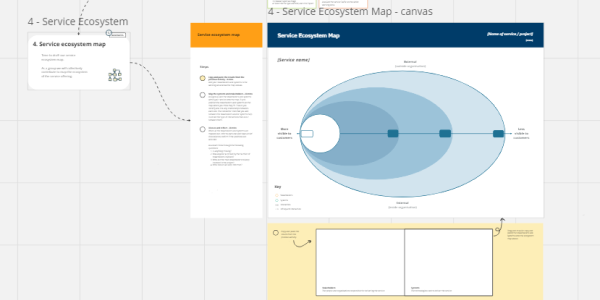Customers come first
Start from the customer's perspective. Whether you’re mapping an existing process or creating one from scratch, it’s crucial to put yourself in your customer’s shoes while mapping the service scenario that you’d like to investigate.
For example, you might think about who is involved in the written-off vehicles process. Starting with the customer, you need to think about who they interact with when their vehicle has been written off, or who they interact with if they are trying to buy or register a vehicle that has been written off. From there you think about who those stakeholders interact with. There’s no stopping rule for a service ecosystem map, but you’ll know when you have enough detail to support the decisions you need to make.
You can also consider the systems that a customer, or another stakeholder on your service ecosystem map needs to interact with. You can position them near the stakeholders responsible for those systems. Thinking about systems and stakeholders might help you identify more or different systems and stakeholders.
For example, a customer might purchase a vehicle and check its status on the PPSR (Personal property security register). The PPSR is a system that exchanges data with NEVDIS (National exchange of vehicle and driver information system). After deciding to re-register their previously written-off vehicle, the customer might come to their local TMR customer service centre and interact with a customer service officer who uses TRAILS which interacts with NEVDIS. An ecosystem map can show you all these interactions.
Define the goal
Reflect on your scope and focus. Identify one scenario (your scope) and its corresponding customers.
A service ecosystem map can provide the necessary level of detail to boost your confidence and make well-informed decisions.
You’ll need to choose whether your service ecosystem map is a current or future state. A current state service ecosystem map gives insight into an existing service, while a future state service ecosystem map gives you the opportunity to think about potential changes or challenges. If the service already exists, you need to make a current state service ecosystem map before making a future state, even if your focus is only on the future.
Find support
Pull together a multi-disciplinary team who collectively have awareness of each part of the service. The composition of your service ecosystem mapping team should be related to the context, scenario, and goal of your service ecosystem map.
Because an ecosystem map is an overview, you don’t need to ensure you have all the subject matter experts for all parts of the service in the room at the same time. In fact, that might be counterproductive. Instead, try to find the balance between a small enough team and enough breadth of knowledge so that you can be somewhat confident that your first attempt at a service ecosystem map is close. Don’t aim for perfection.
You might need to think broadly about who is involved in delivering your service before you invite people to be on the service ecosystem mapping team. You might even need to take an iterative or evolving approach and create your service ecosystem map over time.
Just remember that your service ecosystem map only needs to be useful as an overview of the complexity of a service. The point of doing a service ecosystem map isn’t the map, it’s having an overview of the service and systems that you can share with other people.
Invite your participants
It’s important to give enough notice to ensure participants can come along to the session. Aim to send invitations about 2 weeks in advance.
You’ll want to make sure when you send an invite for the session, that you clearly explain the goal, how long it’ll take, and why people’s participation will be beneficial.
You can use our email invitation template for this.
Calendar invite service ecosystem mapping
Subject:You're invited to help complete a service ecosystem map for [project name]
Meeting description:Hi [team name if sending a group invitation, or participant name if sending individual invitations],
As part of [name of project], we'd like to get everyone together to create a service ecosystem map. In this session we’ll identify the systems and stakeholders who customers interact with to understand the impact of our project.
The session will take about [time] and there is no preparation required.
I look forward to your contribution to the session.
Kind Regards,
[facilitator name]




